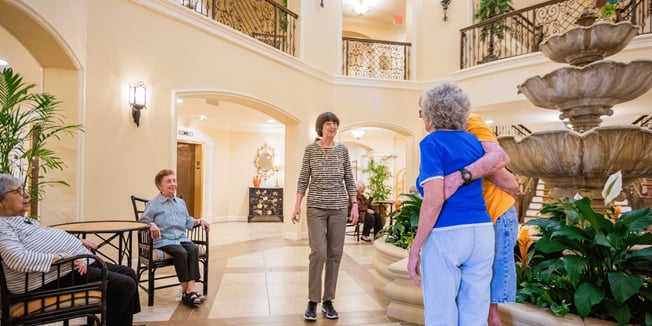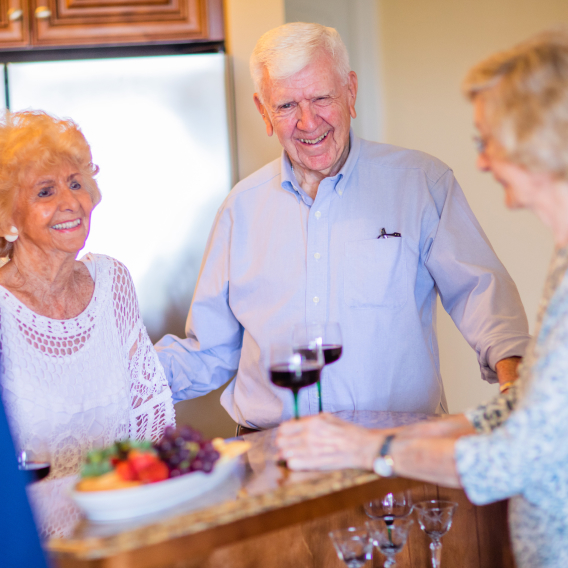Is a Medical Alert System the Right Choice for Your Parents?

It’s natural to worry more about your parents and loved ones as they age. With this worry comes the desire to ensure their safety and quick access to assistance in the event of a medical emergency.
One option for seniors is a medical alert system. However, without a solid understanding of what medical alert systems are and how they work, you may choose a system that doesn’t meet your loved one’s needs.
Let’s explore the different types of medical alert systems, their pros and cons, and what exactly these systems do.
What Is a Medical Alert System and How Does It Work?
Medical alert systems come with a variety of functionality options and system components. As you’re shopping for the best choice, be sure to understand the following system basics.
System Components
Medical alert systems have two components: the equipment itself and the accompanying 24/7 medical service. The equipment consists of the base unit or wearable device as well as other optional accessories such as wall-mounted buttons. You may also choose add-ons such as medication reminders or location tracking, but depending on the system and monitoring provider, additional one-time or monthly fees may be required.
System Functionality
Alert systems include a lightweight wearable help button that can be worn around the neck as a necklace, around the wrist as a bracelet, put into a pocket, or worn around a belt loop—whichever is most convenient for your senior loved one.
When they press the alert system button, they’ll be quickly connected to a trained professional. If your loved one’s alert system includes built-in fall detection, an automatic alert will be sent to the monitoring center when a fall is detected.
Some medical alert systems include two-way communication so your loved one can speak directly to the monitoring center staff, and the staff member can evaluate the situation and determine the best course of action. Once the staff at the monitoring center assess the situation by talking with your loved one, they’ll send emergency services if needed.
Is it still safe to drive? Assess driving ability, get a risk score and learn what you can do now.
Take the AssessmentWhat Medical Alert System Options Are Available?
When it comes to functionality and features, you have a handful of choices to make. Depending on your senior loved one’s overall health, you should customize those choices to meet their needs.
Monitored vs. Unmonitored Systems
A monitored system is connected to a center staffed with trained professionals who oversee the emergency calls and assess the situation quickly, connecting to 911 or a list of your loved one’s emergency contacts. Monitored systems include additional monthly charges, but they also offer benefits and services that unmonitored systems don’t. Staff members at monitoring centers go through rigorous training so they understand how to best respond to an emergency.
Unmonitored systems don’t connect to a central monitoring center. Instead, they automatically connect to an emergency contact or 911. A downside of unmonitored systems is that your loved one may not always need 911 when an incident occurs. In that case, emergency personnel arrive at your loved one’s home without important contextual information. Additionally, with an unmonitored system, the senior’s emergency contacts may miss the alert notification.
At-Home System vs. On-the-Go System
At-home equipment has a base unit in your loved one’s home. The unit connects to sensors mounted to the wall or wearable device. If you choose an on-the-go system, a base unit usually isn’t installed.
With at-home systems, a cellular or landline connection is required to communicate with the monitoring center. Note that with a cellular connection, your loved one will be using the cellular connection of the medical alert company. They need to live in an area where the cellular provider has a strong signal, so check with the alert monitoring company to find out which cellular provider they use and seek out a system with a provider that has a strong signal in your area.
Fall Detection Features
Fall detection technology can be built into the medical alert system to sense when your loved one has fallen. When a fall is identified, it sends a notification to the medical alert company that your loved one needs help. Many alert systems include a sensor that can be integrated into a mobile device or worn around the neck or wrist. Wearing the sensor around the neck is more accurate than around the wrist because arm motions such as waving or stirring ingredients in a cooking pot can cause a false alarm.
Medical Alert Systems or Assisted Living: Which Is Best for Your Loved One?
Medical alert systems may provide help in case of an emergency or a fall, but there are significant areas of concern that an alert system can’t monitor. It’s important to know if your senior loved one isn’t eating, if they’re making medication mistakes, if they’re lonely, and more. Senior living communities are well-equipped to help with these quality-of-life issues.
Trained staff in assisted living communities are accustomed to helping with medication management, dressing, and other services your loved one needs while they live their best life. Senior living communities offer additional benefits and support for healthy living such as delicious dining options that ensure residents are getting the healthy foods they need. For example, Cedarhurst Senior Living offers our Crafted by Cedarhurst℠ dining program that provides a variety of menu specialties including gluten-free, diabetic-friendly, and low-sodium options as well as regional specialties and familiar favorites.
Senior living communities are also designed around socialization opportunities to prevent isolation and loneliness. Shared spaces such as dining areas and on-site calendar events such as art classes and book clubs help residents make new friends while strengthening existing connections.
One of the largest benefits of senior living communities is the ability to receive immediate medical assistance when needed. Communities are staffed with specially trained team members around the clock so they can be on-hand to assist residents immediately in case of a fall or other emergency.
Ready to Take the Next Step in Learning More About Senior Living?
One of the driving factors in a decision regarding senior living or a medical alert system is cost. A medical alert system has a small initial fee and monthly fees, but it doesn’t provide the caring support of a team of professionals who are beside your loved one every day, noticing small changes and responding with immediate medical assistance when necessary.
Assisted living communities often cost a lot less than families think. For a true understanding of the price of senior living compared to your senior loved one’s current living costs, we encourage you to explore our personalized cost calculator.






.png?width=307&height=200&name=Blog%20%2333%201400%20x%20700%20(1).png)

.png?width=307&height=200&name=Blog%20%2332%201400%20x%20700%20(8).png)



